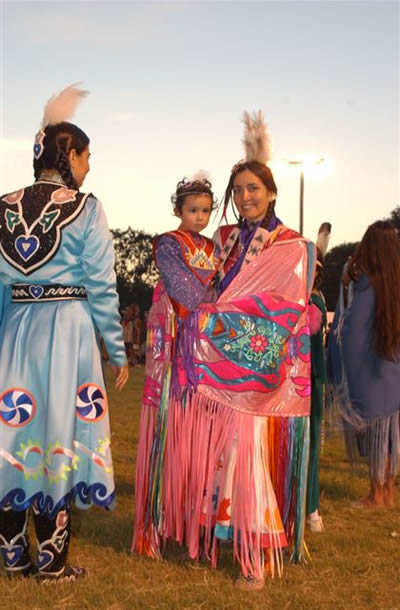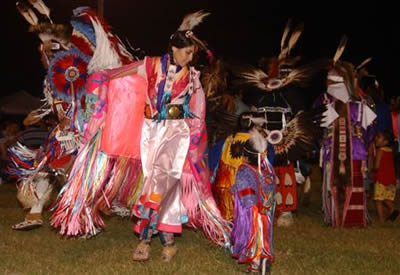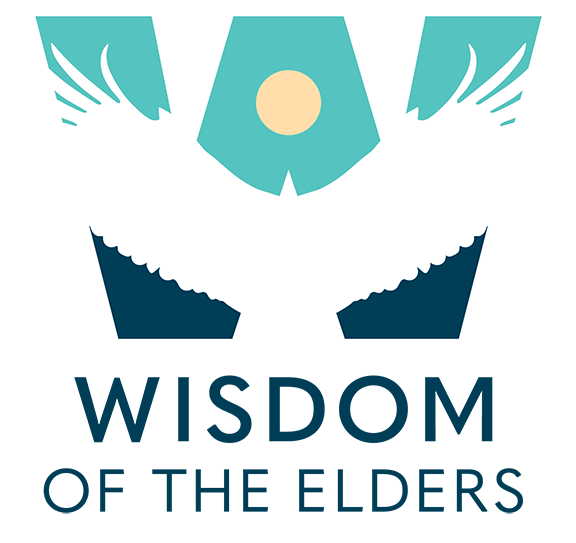Kricket Connywerdy Stories
 Ah ho. Thank you for allowing me to share some stories with you. My name is Kricket Rhoads-Connywerdy. I am Kiowa and Caddo and I am a member of the Caddo Nation. The Caddo Tribe of Oklahoma and I’m a Henry on my Caddo side and a Keah Bone on my Kiowa side. Keah Bone means savior in Kiowa. From what I understand, my ancestor went and when they were having a battle the people would fall on the battleground and he would go out and bring them back to safety when they weren’t able to reach it on their own. So that’s how we got the name Keah Bone, which means savior.
Ah ho. Thank you for allowing me to share some stories with you. My name is Kricket Rhoads-Connywerdy. I am Kiowa and Caddo and I am a member of the Caddo Nation. The Caddo Tribe of Oklahoma and I’m a Henry on my Caddo side and a Keah Bone on my Kiowa side. Keah Bone means savior in Kiowa. From what I understand, my ancestor went and when they were having a battle the people would fall on the battleground and he would go out and bring them back to safety when they weren’t able to reach it on their own. So that’s how we got the name Keah Bone, which means savior.
The first story I’m going to share with you is a small short story and it’s from the Caddo Nation. I will share part of it with you and if you like it then let me know and I will share the whole thing with you whenever you get a chance to invite me up to do storytelling. There’re many reasons why we tell stories. To teach lessons, things you should do, things you shouldn’t do, to explain why things are the way they are, and also for the fun of entertainment. I like to share this story because it combines all three of those things. And it takes place a long time when dogs could still talk. There was a man named flying hawk he was a very good hunter but he knew he could be a better hunter if he had a dog. But he didn’t like dogs because dogs would always go around and they talk and they’d tattle and tell all of their owner’s business to everybody else. One day Flying Hawk’s friend came up to him and said, Flying Hawk why don’t you come over and pick a puppy out of my dog’s litter. Flying Hawk said, I don’t know, all they do is talk and tattle and they tell where all of my secret hunting places are. Flying Hawk’s friend said, why you could teach them not to tattle and you’d be a better hunter with a dog. Flying hawk thought well, I guess I could teach them not to tattle and well it wouldn’t hurt to be a better hunter than I already am. So he went over and he picked a cute little puppy out of the litter and took it home with him. But every day like Flying Hawk thought that puppy would run off into the village and tattle. He’d say, woof, I caught a big old deer today; woof, and Flying Hawk would get really angry with his dog. Deetsee , that’s how you say dog in Caddo. Deetsee . Deetsee if you keep on tattling I’m going to have to pull out your tongue. Well, finally Deetsee listened to him and he quit tattling. That’s a little excerpt from a story I would tell to younger people.
I have another story. It’s a Kiowa story. To me, it’s very close to my family history. It explains a lot of things about the Kiowas, about a lot of the plains Indians, and our predicament that we are in today or how we came to be where we are today. It takes place in Oklahoma when it was still Indian Territory.
 Now it was always supposed to be Indian Territory as long as the sky was blue and the grass is green, but I don’t know maybe they found oil or something. But the government the United States government started building a railroad through the Indian Territory. The aungaupi, that’s how you say buffalo in Kiowa, means our people’s food. The aungaupi leader knew that this railroad was going to be detrimental to the Kiowas so he told all the aungaupi to go out and dig up the railroad tracks. So they did. Well, then people started putting up fences. I guess if anybody has ever heard of boomer Sooners, those are probably the Sooners, and they started putting up fences. Well, the aungaupi leader knew those were bad too so all the aungaupi would go and knock those down. But no matter what the aungaupi did the railroad tracks were finally completed and trains started going through and people would stick their guns and their rifles out of the train windows and shoot the aungaupi for no reason. Now when Kiowa shot the aungaupi they used every part of it. But when these people shot it they just went on. That is a part of the story the beginning of the story about what happened to the aungaupi and what happened to the Kiowa people. When I talk about my family history that story goes with it very well.
Now it was always supposed to be Indian Territory as long as the sky was blue and the grass is green, but I don’t know maybe they found oil or something. But the government the United States government started building a railroad through the Indian Territory. The aungaupi, that’s how you say buffalo in Kiowa, means our people’s food. The aungaupi leader knew that this railroad was going to be detrimental to the Kiowas so he told all the aungaupi to go out and dig up the railroad tracks. So they did. Well, then people started putting up fences. I guess if anybody has ever heard of boomer Sooners, those are probably the Sooners, and they started putting up fences. Well, the aungaupi leader knew those were bad too so all the aungaupi would go and knock those down. But no matter what the aungaupi did the railroad tracks were finally completed and trains started going through and people would stick their guns and their rifles out of the train windows and shoot the aungaupi for no reason. Now when Kiowa shot the aungaupi they used every part of it. But when these people shot it they just went on. That is a part of the story the beginning of the story about what happened to the aungaupi and what happened to the Kiowa people. When I talk about my family history that story goes with it very well.
Because my great-grandmother was born at the last winter camp at the turn of the last century –1900. She was born in 1900 on Christmas Eve. There was a little boy born the same time she was – on Christmas Eve. By then Kiowas had heard of the bible so they named her Mary and they named him Joseph. Then after that, they were issued houses that story goes along with that. What happened to the Kiowas today and what happened with my family. And before she was born she had some siblings. The Kiowas at that time were still nomadic, still trying to find the last of the southern buffalo herd. There were over a million. That went down to thirty and then those were killed. They were still trying to find the last of the buffalo herd, the aungaupi, when the government, the United States government at Fort Sill in Lawton, Oklahoma rounded up all those people that wouldn’t stay stationary and kept following the aungaupi – how they always lived for years and years – and told them they had to stay stationary. They put them in a corral that winter. You’ll see that corral if you ever get to visit Fort Sill in Lawton, Oklahoma. They put them in this corral where animals should be and if they left that corral they would get shot and killed. Well they weren’t issued enough food or enough clothing to last to survive the winter so a lot of them perished and some of her older siblings perished during that time. I lived with my great-grandmother in the summertime in August during the Indian fair time and got to be with her up until she died when I was 15 years old. So that was a very recent time in my family history. These are stories that I share.
I also share songs. We have one song that I put in a story about the Zaide-Tali, that’s the two half boys. They taught the Kiowas many lessons. This song I put in there is what a grandmother sings to a grandbaby when they are firstborn. And it’s a comforting song. It goes like this:
Sings in language.
What that song is saying; its saying baby why are you nursing off your mother when she is no longer living. It’s still a comforting song for the Kiowa people to sing to the babies. We have other songs after that that we do. Its’ part of my presentation and this next one is a muscle-building song. The children go to rabbit dances still today on the Fourth of July during Gourd Clan, which my husband is a member of and they have these rabbit dances they’re an integral part of our society the children are the rabbit society. This other song is another muscle building song, rabbit dance song, and it goes like this:
Sings in language.
The kids jump up and down like rabbits. So it’s part of my presentation. That’s what we will do if we have children. If it’s an older group I would have more history. We also do, within my stories, signing. Sign language – Southern Plains/plains Indians sign language A lot of people come up to me later, years later, groups that I’ve been to and they’ll show me the sign for good. They’ll show me the sign for Kiowa. They remember it!! So I thought that was really cool. Those are some of the things that I do in my presentation. I hope that you enjoy these little excerpts of what I have. I hope. Thank you.
Kricket Connywerdy
Kricket Rhoads-Connywerdy is Kiowa and an enrolled member of the Caddo Tribe of Oklahoma. Kiowas were originally from the Yellowstone area, Oklahoma, Texas, Kansas, and Colorado. The Caddo were around Louisiana, Texas and finally ended in Oklahoma. The Caddo were agrarian woodland people that were mound builders and stomp dancers. The Kiowa were southern plains people who followed the augaupi (buffalo).
Kricket was eighteen and just starting to tell stories on her own when she heard a story from an older storyteller about what happened to the augaupi (buffalo), food for the Kiowa people. When the US made treaties with the Kiowa they would not encroach upon Kiowa land without permission. Later the government decided to build a railroad through Kiowa land without permission. The augaupi leader told all the buffalo to dig up the railroad. The 10th Cavalry was hired to kill all buffalo but the augaupi continued. After much toil, the railroads were completed and trains came through Kiowa land. People would point their guns and rifles out of the train windows and shoot the augaupi for target practice. Finally, the augaupi leader realized he could no longer help his Kiowa people. Out of over one million buffalo, less than thirty remained. He gathered what remained of his augaupi and headed for Mount Scott. Early in the morning a young woman woke and walked outside her tipi. The mist parted and she saw the augaupi leader leaving her. Mount Scott opened up and the rest of the augaupi walked in. That was how the old Kiowa way of life ended. Today, Kricket uses this story to explain what happened to the Kiowa people and her family as well.
Kricket has told traditional Kiowa and Caddo stories throughout the United States and internationally since 1988. Kricket incorporates family stories and history. She helps the audience understand the diversity of American Indians by sharing the different languages, songs and dances of the Kiowa and the Caddo people. She brings the audience into the stories by having them participate in language, sign language, singing, and dancing. She wears her traditional Kiowa clothes and accurately describes her clothing. Kricket talks about Kiowa customs and Indian Oklahoma and Indian federal history. Her presentations are all-encompassing. She combines the traditional form of storytelling with the modern world of the Native Americans.
Kricket is a member of a professional Native American dance troupe called Oklahoma Fancy Dancers. All the performers are enrolled tribal members, most of whom are full blood representing various tribes. Oklahoma Fancy Dancer dancers, singers, musicians, bead workers, feather workers, seamstresses all place first in competitions throughout the Indian country. They have traveled all over Europe, Russia, Asia, the Mediterranean, Slavic, Scandinavian countries, and many other countries. Kricket dances traditional Kiowa Buckskin and Cloth as well as Northern Fancy Shawl and Jingle. She has placed in fancy shawl and buckskin at powwows and has awards for ballet dancing. She also served as Goul hae ee descendent princess, (family princess) for the years 1999 and 2000. Kricket gives lectures and demonstrates traditional dances.
Kricket has performed on stage since childhood in a variety of roles: acting, dancing, and singing. She studied under Moscelyn Larkin, one of the five Indian prima ballerinas from Oklahoma, for fifteen years. She danced as an apprentice for Tulsa Ballet Theater Company as a teenager. She has also taken modern dance from Denise Vale (a Martha Grahmn student) and ballet classes at Oklahoma University.
Kricket has had lead roles in The Alamo movie and Chasing the Wind as well as parts in Last of the Mohicans and UHF. She has been in commercials including one with her daughter for the 2004 WIC nursing campaign and the WB promotional as well as several others. She has been on Walker Texas Ranger and other types of roles as well.
Kricket has her associate’s degree and is continuing her education at Oklahoma University where she is a senior in the Native American Studies Department. Kricket works at The Historic Jacobson House Native Art and Cultural Center in Norman Oklahoma as the Programs and Projects coordinator. Kricket’s two children also participate in their cultural activities.
Her presentations are good for schools, tribal organizations, business and civic organizations, sovereignty symposiums, museums, and festivals. She is an interactive storyteller.
Kricket Rhoads-Connywerdy
1200 W. Brooks
Norman, OK 73069
405-360-2532
kricketandkevin@peoplepc.com
